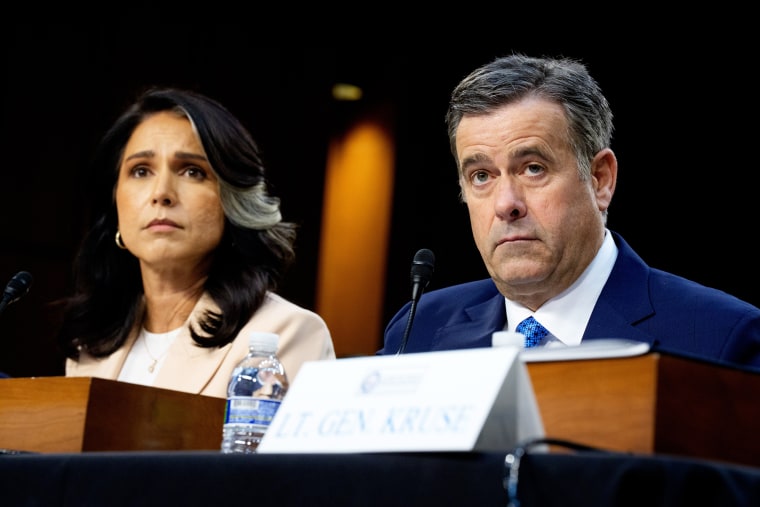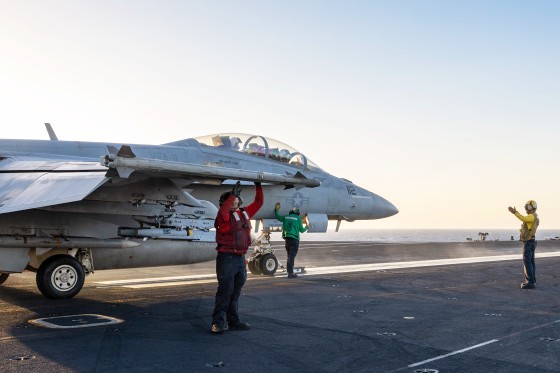Former senior national security officials and Democratic lawmakers rejected on Wednesday the Trump administration’s continued assertion that detailed U.S. airstrike plans inadvertently shared with a journalist were not classified.
They cited The Atlantic's publication of a full transcript of the Signal text exchange where the administration's top national security officials discussed planned U.S. airstrikes in Yemen.
Defense Secretary Pete Hegseth, according to the magazine, shared the precise timing of planned fighter jet and drone launches, when bombs would hit their targets and disclosed a U.S. attempt to kill a "target terrorist." Hegseth, though, did not include specific targeting locations for the strikes in Yemen.
But four former national security and intelligence officials who handled legal matters told NBC News that information about an upcoming military attack on an adversary — including types of weapons and the timing of airstrikes — is considered classified.
“I don’t think there is any question that we are dealing with classified information,” Leon Panetta, a former CIA director and defense secretary, told MSNBC on Tuesday.
Plans for possible military operations are kept strictly secret because the Defense Department “recognizes that if that information were to leak to an adversary, that it would not only cost lives but would damage our national security,” Panetta said.
The three other officials, who spoke on condition of anonymity citing fears of retaliation, said it would be difficult to imagine a scenario in which details of a planned military operation would not be considered classified.
Sharing sensitive information in advance of an operation could put pilots flying fighter jets or the crews of warships launching missiles at risk or even imperil the mission itself, former officials said.
According to a Pentagon manual on classification, significant military plans or intelligence matters are defined as “secret” and their disclosure could cause “serious damage to operations, assets or individuals.”
In a 2014 guide, the national intelligence director’s office said that “information providing indication or advance warning that the U.S. or its allies are preparing an attack” should be treated as top secret.

Detailed timeline of attacks
The publication of the full group chat confirmed Atlantic editor Jeffrey Goldberg’s initial account that Hegseth posted details about the imminent military operation on the commercial, open-source Signal app, unaware that Goldberg had been inadvertently invited into the text chain.
“1215et: F-18s LAUNCH (1st strike package),” one of the texts says, referring to U.S. F-18 fighter jets launching to apparently conduct the first set of attacks. “1345: ‘Trigger Based’ F-18 1st Strike Window Starts.”
Hegseth also posted the planned sequencing of the aerial attack, describing the timing of a second takeoff by F-18 warplanes and noting that by 2:15 p.m., drones would reach their targets. He wrote, “(THIS IS WHEN THE FIRST BOMBS WILL DEFINITELY DROP).”
There was also a discussion in the chat about a strike on a Houthi leader that appeared to be based on detailed intelligence regarding his whereabouts. Hegseth posted on the chat, "(Target Terrorist is @ his Known Location so SHOULD BE ON TIME)"
National Security Adviser Mike Waltz, who set up the Signal text chat and mistakenly invited Goldberg, wrote that a strike hit a “top missile guy” who was identified as he was “walking into his girlfriend’s building,” according to the transcript. A U.S. strike caused the building to collapse, the text says.
An error that caused no harm
For a second day, Trump administration officials continued to downplay the incident, portraying it as a mistake that caused no harm and claiming no classified information had been disclosed.
Asked by NBC News’ Peter Alexander at a news conference how the administration would characterize the group chat, White House press secretary Karoline Leavitt said: “I would characterize this thread as a policy discussion, a sensitive policy discussion ... amongst high-level Cabinet officials and senior staff.”
Asked whether anyone would lose his or her job over, Leavitt said President Donald Trump continues to have confidence in his national security team.
To support their argument that the chat included no classified information, Trump administration officials said the text chain included no details about intelligence sources or methods, the specific locations of military targets or the names of military units involved in the attack.
“There were no sources, methods, locations or war plans that were shared,” Tulsi Gabbard, the director of national intelligence, testified to the House Intelligence Committee on Wednesday.
Democratic push back
But Democratic lawmakers, including those who have served in the military, argued those assertions made little sense.
Rep. Jason Crow, D-Colo., a combat veteran, argued that the release of the timing of the strikes and the aircraft used — if it had been obtained by the Houthis or their longtime backer, Iran —would have endangered U.S forces and limited the effectiveness of the operation.
Crow noted that the Houthis have advanced air-defense systems and that they have used to shoot down multiple U.S. MQ-9 Reaper drones, one of the weapons employed in the strikes in Yemen. He said it was outrageous that the administration was not accepting responsibility for its actions.
“It is a leadership failure, and that’s why Secretary Hegseth, who undoubtedly transmitted classified sensitive operational information via this chain, must resign immediately,” Crow said.
